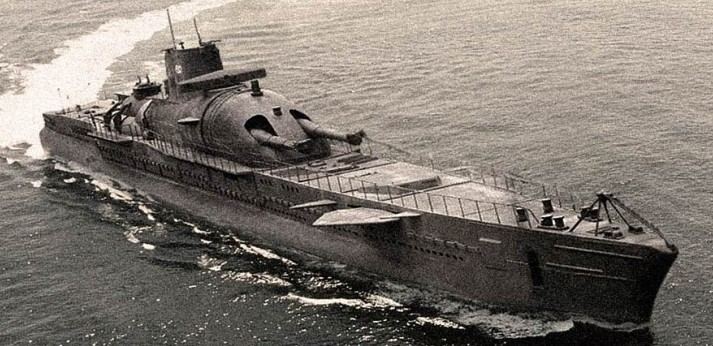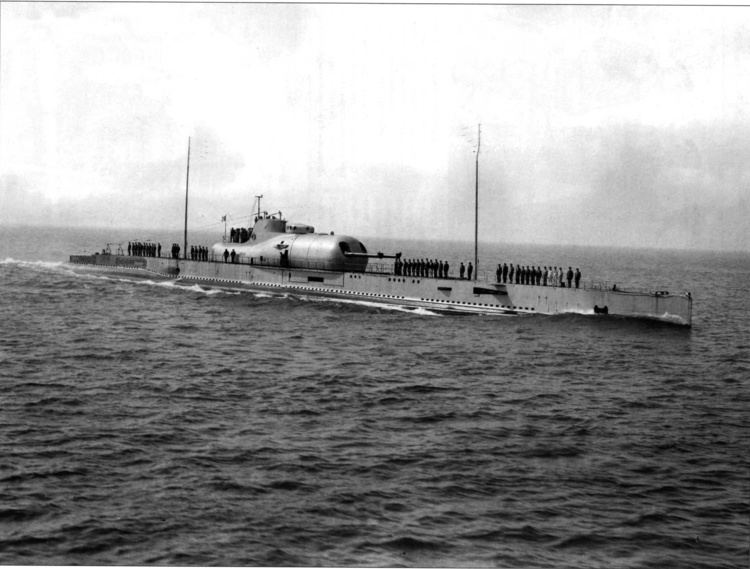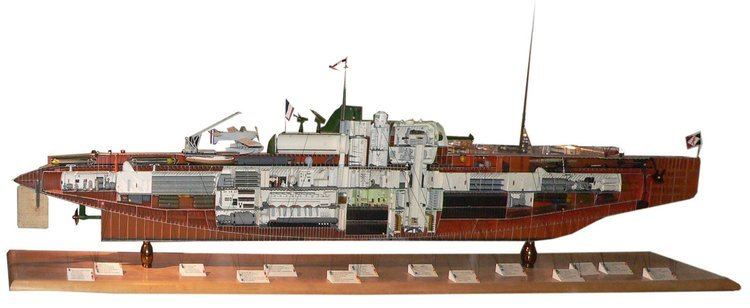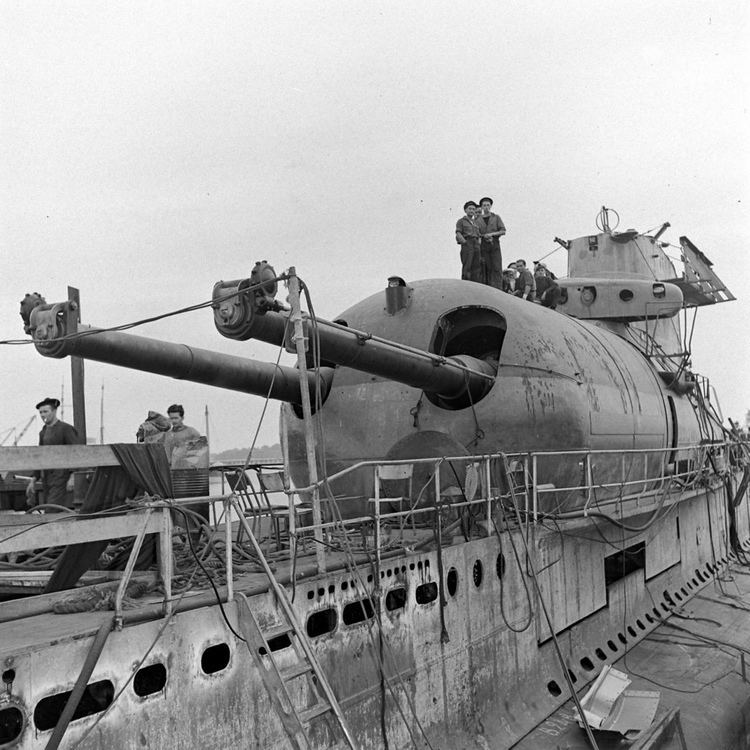Name Surcouf Ordered 4 August 1926 Commissioned 3 May 1934 Construction started 1 October 1927 Length 110 m Endurance 3 months | Laid down 1 October 1927 In service 1934–1942 Launched 18 October 1929 Beam 9 m | |
 | ||
General charles de gaulle and admiral muselier visit the french submarine surcouf hd stock footage
Surcouf was a French cruiser submarine ordered to be built in December 1927, launched on 18 October 1929, and commissioned in May 1934. Surcouf – named after the French privateer Robert Surcouf – was the largest submarine ever built until surpassed by the first Japanese I-400-class submarine in 1943. Her short wartime career was marked with controversy and conspiracy theories. She was classified as an "undersea cruiser" by sources of her time.
Contents
- General charles de gaulle and admiral muselier visit the french submarine surcouf hd stock footage
- Design
- Early career
- Second World War
- Free French naval forces
- Liberation of St Pierre and Miquelon
- Later operations
- Fate
- Theories on the loss of Surcouf
- Honors
- Commanding officers
- Surcouf in fiction
- References

Design

The Washington Naval Treaty had placed strict limits on naval construction by the major naval powers, but submarines had been omitted. The French Navy attempted to take advantage of this by building three "corsair submarines", of which Surcouf was the only one to have been completed.

Surcouf was designed as an "underwater cruiser", intended to seek and engage in surface combat. For reconnaissance, she carried a Besson MB.411 observation floatplane in a hangar built abaft of the conning tower; for combat, she was armed with six 550 mm (22 in) and four 400 mm (16 in) torpedo tubes and twin 203 mm (8 in) guns in a pressure-tight turret forward of the conning tower. The guns were fed from a magazine holding 60 rounds and controlled by a director with a 5 m (16 ft) rangefinder, mounted high enough to view a 11 km (5.9 nmi; 6.8 mi) horizon, and able to fire within three minutes after surfacing. Using her periscopes to direct the fire of her main guns, Surcouf could increase this range to 16 km (8.6 nmi; 9.9 mi); originally an elevating platform was supposed to lift lookouts 15 m (49 ft) high, but this design was abandoned quickly due to the effect of roll. In theory, the Besson observation plane could be used to direct fire out to the guns' 24 mi (21 nmi; 39 km) maximum range. Anti-aircraft cannon and machine guns were mounted on the top of the hangar.

Surcouf also carried a 4.5 m (14 ft 9 in) motorboat, and contained a cargo compartment with fittings to restrain 40 prisoners. The submarine's fuel tanks were very large; enough fuel for a 10,000 nmi (19,000 km; 12,000 mi) range and supplies for 90-day patrols could be carried.

Although she had her impressive specification, Surcouf proved to be plagued by mechanical problems: her trim was difficult to adjust during a dive, on the surface she rolled badly in rough seas, and she took over two minutes to dive to a depth of 12 m (39 ft), making her vulnerable to aircraft.
Early career

Soon after Surcouf was launched, the London Naval Treaty finally placed restrictions on submarine designs. Among other things, each signatory (France included) was permitted to possess no more than three large submarines, each not exceeding 2,800 long tons (2,800 t) standard displacement, with guns not exceeding 6.1 in (150 mm) in caliber. Surcouf, which would have exceeded these limits, was specially exempt from the rules at the insistence of Navy Minister Georges Leygues, but other 'big-gun' submarines of her class could no longer be built.
Second World War
In 1940, Surcouf was based in Cherbourg, but in May, when the Germans invaded, she was being refitted in Brest. With only one engine functioning and with a jammed rudder, she limped across the English Channel and sought refuge in Plymouth.
On 3 July, the British, concerned that the French Fleet would be taken over by the German Kriegsmarine at the French armistice, executed Operation Catapult. The Royal Navy blockaded the harbours where French warships were anchored and delivered an ultimatum: re-join the fight against Germany, be put out of reach of the Germans or scuttle the ships. Most accepted willingly, with two notable exceptions: the North African fleet at Mers-el-Kebir and the ships based at Dakar (West Africa). The French battleships at North Africa were eventually attacked and sunk at their moorings by the Mediterranean Fleet.
French ships lying at ports in Britain and Canada were also boarded by armed marines, sailors and soldiers, and the only serious incident took place at Plymouth aboard Surcouf on 3 July, when two Royal Navy submarine officers, Cdr Denis 'Lofty' Sprague, captain of HMS Thames and Lt Griffiths of HMS Rorqual, and French warrant officer mechanic Yves Daniel were fatally wounded, and a British seaman, L. S. Webb, was shot dead by the submarine's doctor.
Free French naval forces
By August 1940, the British completed Surcouf's refit and turned her over to the Free French Navy (Forces Navales Françaises Libres, FNFL) for convoy patrol. The only officer not repatriated from the original crew, Capitaine de Frégate (Commander) Georges Louis Blaison, became the new commanding officer. Because of the British-French tensions with regard to the submarine, accusations were made by each side that the other was spying for Vichy France; the British also claimed that Surcouf was attacking British ships. Later, a British officer and two sailors were put on board for "liaison" purposes. One real drawback of this submarine was that it required a crew of 110–130 men, which represented three crews of more conventional submarines. This led to Royal Navy reluctance to recommission her.
Surcouf then went to the Canadian base at Halifax, Nova Scotia and escorted trans-Atlantic convoys. In April 1941, she was damaged by a German plane at Devonport.
On 28 July, Surcouf went to the United States Naval Shipyard at Portsmouth, New Hampshire for a three-month refit. The U.S. was technically violating its neutrality as the U.S. had diplomatic relations with Vichy France at the time and did not recognize Free France. As Free France was allied with the United Kingdom and, therefore, a belligerent, the United States was violating neutrality by giving military assistance to a belligerent, as it had done with the Lend-Lease agreement and the neutrality patrol.
After leaving the shipyard, Surcouf went to New London, Connecticut, perhaps to receive additional training for her crew. Surcouf left New London on 27 November to return to Halifax.
Liberation of St. Pierre and Miquelon
In December 1941, Surcouf carried the Free French Admiral Émile Muselier to Canada, putting in to Quebec City. While the Admiral was in Ottawa, conferring with the Canadian government, Surcouf's captain was approached by New York Times reporter Ira Wolfert and questioned about the rumours that the submarine would liberate Saint-Pierre and Miquelon (a French archipelago 10 kilometres from Newfoundland) for Free France from Vichy control. Wolfert accompanied the submarine to Halifax, Nova Scotia where, on 20 December, they joined the Free French corvettes Mimosa, Aconit, and Alysse, and on 24 December took control of the islands for Free France without resistance.
United States Secretary of State Cordell Hull had just concluded an agreement with the Vichy government guaranteeing the neutrality of French possessions in the Western hemisphere, and he threatened to resign unless President of the United States Franklin D. Roosevelt demanded a restoration of the status quo. Roosevelt did so, but when Charles de Gaulle refused, he dropped the matter. Ira Wolfert's stories – very favourable to the Free French (and bearing no sign of kidnapping or other duress) – helped swing American popular opinion away from Vichy. The Axis Powers' declaration of war on the United States in December 1941 negated the agreement but the U.S. did not sever diplomatic ties with the Vichy Government until November 1942.
Later operations
In January 1942, the Free French decided to send Surcouf to the Pacific theatre of war, after she re-supplied at the Royal Naval Dockyard in Bermuda. Her movement south triggered rumours that she was going to liberate Martinique for the Free French from Vichy.
After the outbreak of war with Japan, Surcouf was ordered to Sydney, Australia via Tahiti. She departed Halifax on 2 February for Bermuda, which she left on 12 February, bound for the Panama Canal.
Fate
Surcouf may have been sunk on 18 February 1942 about 80 mi (70 nmi; 130 km) north of Cristóbal, Colón, while en route for Tahiti via the Panama Canal. The American freighter Thompson Lykes, steaming alone from Guantanamo Bay on what was a very dark night, reported hitting and running down a partially submerged object which scraped along her side and keel. Her lookouts heard people in the water but the freighter carried on its course without stopping, as they thought that they had struck a German U-boat, though cries for help were heard in English. A signal was sent to Panama describing the incident. The loss of Surcouf was announced by the Free French Headquarters in London on 18 April 1942.
Inquiries into the incident were haphazard and late, while a later French inquiry supported the idea that the sinking had been due to "friendly fire"; this conclusion was supported by Rear Admiral Auphan in his book The French Navy in World War II in which he states: "for reasons which appear to have been primarily political, she was rammed at night in the Caribbean by an American freighter." Charles de Gaulle stated in his memoirs that Surcouf "had sunk with all hands".
As no one has officially dived or verified the wreck of Surcouf, its location is unknown. If one assumes the Thompson Lykes incident was indeed the event of Surcouf's sinking, then the wreck would lie 3,000 m (9,800 ft) deep at 10°40′N 79°32′W.
There is a memorial to Surcouf in Cherbourg harbour.
Theories on the loss of Surcouf
As there is no conclusive confirmation that Thompson Lykes collided with Surcouf, and her wreck has yet to be discovered, there are alternative stories of her fate.
Disregarding the predictable story about her being swallowed by the Bermuda Triangle (a fantastical zone that would not be conceptualised until two decades after the submarine's disappearance), one of the most popular is that she was caught in Long Island Sound refuelling a German U-boat, and both submarines were sunk, either by the American submarines USS Mackerel and Marlin, or a United States Coast Guard blimp.
In response to the above theory, Captain Julius Grigore, Jr., USNR (Retired) has offered a one million dollar prize to anyone who can prove that Surcouf engaged in activities which were detrimental to the Allied cause. The prize has yet to be claimed.
James Rusbridger examined some of the theories in his book Who Sank Surcouf?, finding them all easily dismissed except one: the records of the 6th Heavy Bomber Group operating out of Panama show them sinking a large submarine the morning of 19 February. Since no German submarine was lost in the area on that date, it could have been Surcouf. He suggested that the collision had damaged Surcouf's radio and the stricken boat limped towards Panama hoping for the best.
Honors
Commanding officers
Surcouf in fiction
In Casablanca, the member of the French Resistance shot at the beginning carries a leaflet bearing a photograph of Surcouf.
Douglas Reeman's novel Strike from the Sea (ISBN 0-688-03319-9), published in 1978, features a fictional sister ship of Surcouf, named Soufrière.
The model of the titular submarine in Lorelei is based on Surcouf. Particularly noticeable are the 8-inch guns and their housing.
A much enlarged version of Surcouf is also the school ship of Maginot in the Japanese anime Girls und Panzer. It appears briefly, along with other school ships, in one of the original video animations.
A Surcouf-type submarine appears in the Destroyermen novel Deadly Shores by Taylor Anderson, and attacks ships flying American flags. It doesn't come from our own universe, but from an alternate history in which France dominates a fascist alliance (Nazi Germany is a very subordinate partner), so there may be others of its class. The submarine displays an emblem of a red octagon with a white field and a blue cross cercelée, which one of the Americans describes as looking like a "big, fat, blue swastika."
The Christine Kling novel Circle of Bones involves a fictional account of the loss of Surcouf as part of a Skull and Bones conspiracy. It relates the secret society's attempts to destroy the submarine's remains before they could be salvaged in 2008.
